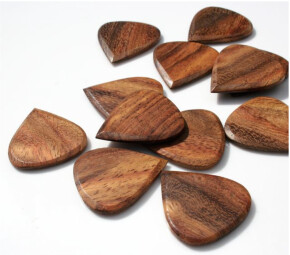If you are like most guitarists, you are on a continual quest to improve your tone and/or discover additional tonal options. This can involve spending thousands of dollars on amps, guitars, pickups, speakers, and effects. But what would you say if I told you could alter your tone for pennies?
Consider this story: One day guitarist Adam Levy (Norah Jones, Ani DiFranco) met jazz guitar legend Jim Hall. Levy asked Hall if he might have one of the master’s picks as a souvenir. Hall reached into his pocket and drew out a handful of plectrums of various shapes and sizes. When Levy wondered aloud if he really used all those different types, Hall explained how he might use a small heavy pick for single line work, or a larger light gauge for his signature rhythm strumming.
|
On the small side of the plectrum spectrum is this Dunlop Eric Johnson Classic Jazz III
|
While different gauges might offer technical advantages for various styles of playing, they also afforded Hall tonal variations: a heavy pick would fatten his single lines, while a thin pick might reduce any muddiness caused by strumming full chords on an already dark-sounding archtop.
Unlike experimenting with guitars, amps, pickups, speakers, and effects, which can ultimately cost as much as a new car, you can take home every type of pick in your music store for the price of a meal at a medium-priced restaurant. You will find that shape, material, and thickness all contribute to tone.
Picks come in a variety of shapes and sizes from the huge celluloid triangles favored by Pat Metheny to the tiny Tortex picks employed by Eric Johnson (see image on right). In addition the aforementioned Tortex and celluloid, they can be made out of nylon, Delrin, tortoiseshell, wood, metal, glass, stone, and other materials both natural and chemical.
Shape up
If you have a typical triangular shaped pick lying around, a quick experiment will demonstrate one way to vary the sound with just this piece of gear. Try picking with the pointed side, then with the more rounded side. Listen closely and you will hear a brighter sound emanating when using the sharper point, and a darker tone with less attack when using one of the rounded edges. Some players use basic Fender heavy- or medium-style picks but employ solely the rounded edges—never the point—for a softer sound.
Here’s an audio example, best listened to on headphones, which demonstrates the tonal differences in pick shapes, thicknesses and material. The first phrase uses the pointy part of pick, and when it repeats, the round part. Next is a medium pick, then a heavy. Finally a plastic pick followed by a metal one.

Weigh the options
You may have decided on a heavy-, medium-, or light-gauge pick because of the way it works for your personal playing technique, without ever considering the effect on your tone. Try purchasing a few lighter and/or heavier versions of your current pick. Play a single clean note on your guitar, over and over, with each weight, concentrating on the tone produced. Going directly from a heavy pick to a light one will offer the most contrast.
The material world
The material of the pick will affect the tone as well. The best way to hear this is to buy the same shape and gauge pick in a number of different materials and listen to the difference. You can even experiment with using a coin as a pick, ala Billy Gibbons’ peso or Brian May’s sixpence.
|
If you want to experiment with a different tone, try a wood pick, such as these Timber Tones
|
After some experimentation, you might find you prefer the tone of a pick in a new shape, gauge, or material. Still, you may resist changing because over the years you have become comfortable with the pick you already use. Don’t worry — you have already unconsciously adjusted the sound of your guitar, amp, and pedals to work with the tone of your pick. You don’t necessarily have to switch, but now that you understand the tonal possibilities available by merely changing up the lowly plectrum, consider some of those sounds as alternatives, for a single tune or when recording in the studio.
For a whole new sound, dispense with the pick altogether and just use your fingers — either permanently like Jeff Beck, Daniel Lanois, and John Abercrombie, or, like many other players, as just one more tone in your palette.
Pick of the litter
Whether you find a plectrum that helps define your sound or choose to vary picks for the occasion, you should be aware of this simple, cheap way to alter your tone. Before you empty your wallet in search of that perfect sound, start with your pocket change and the pick.




